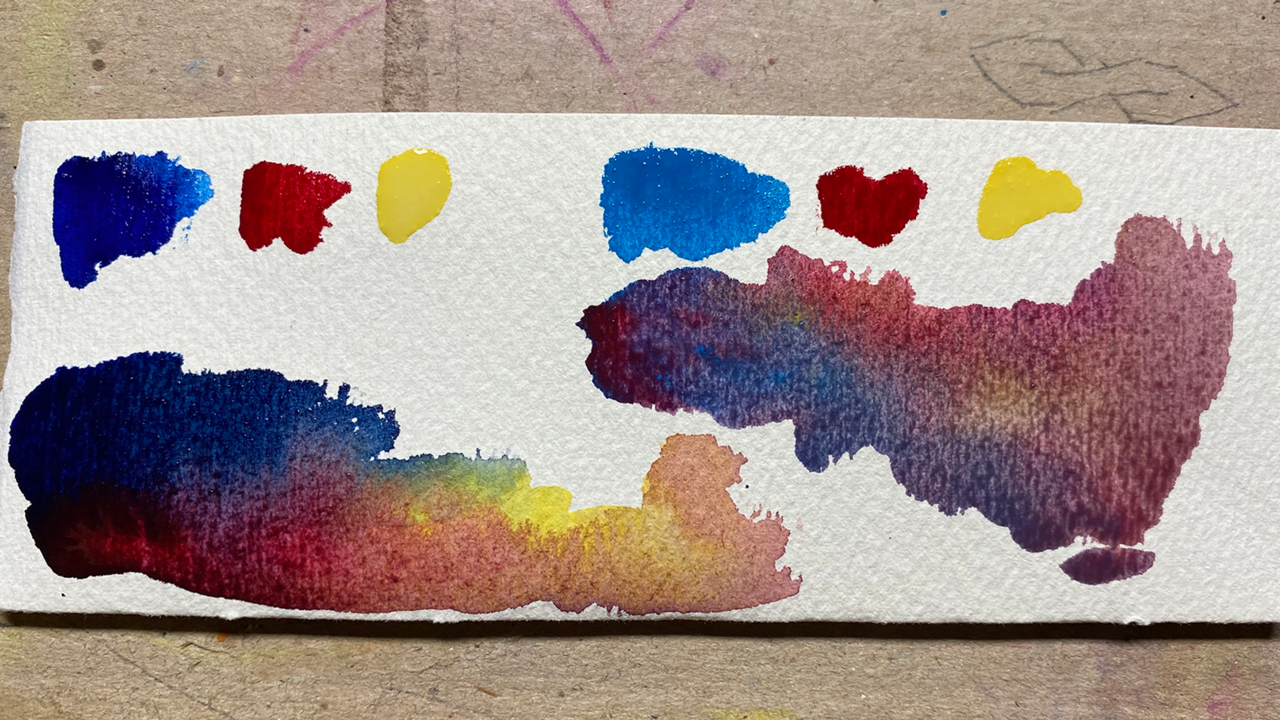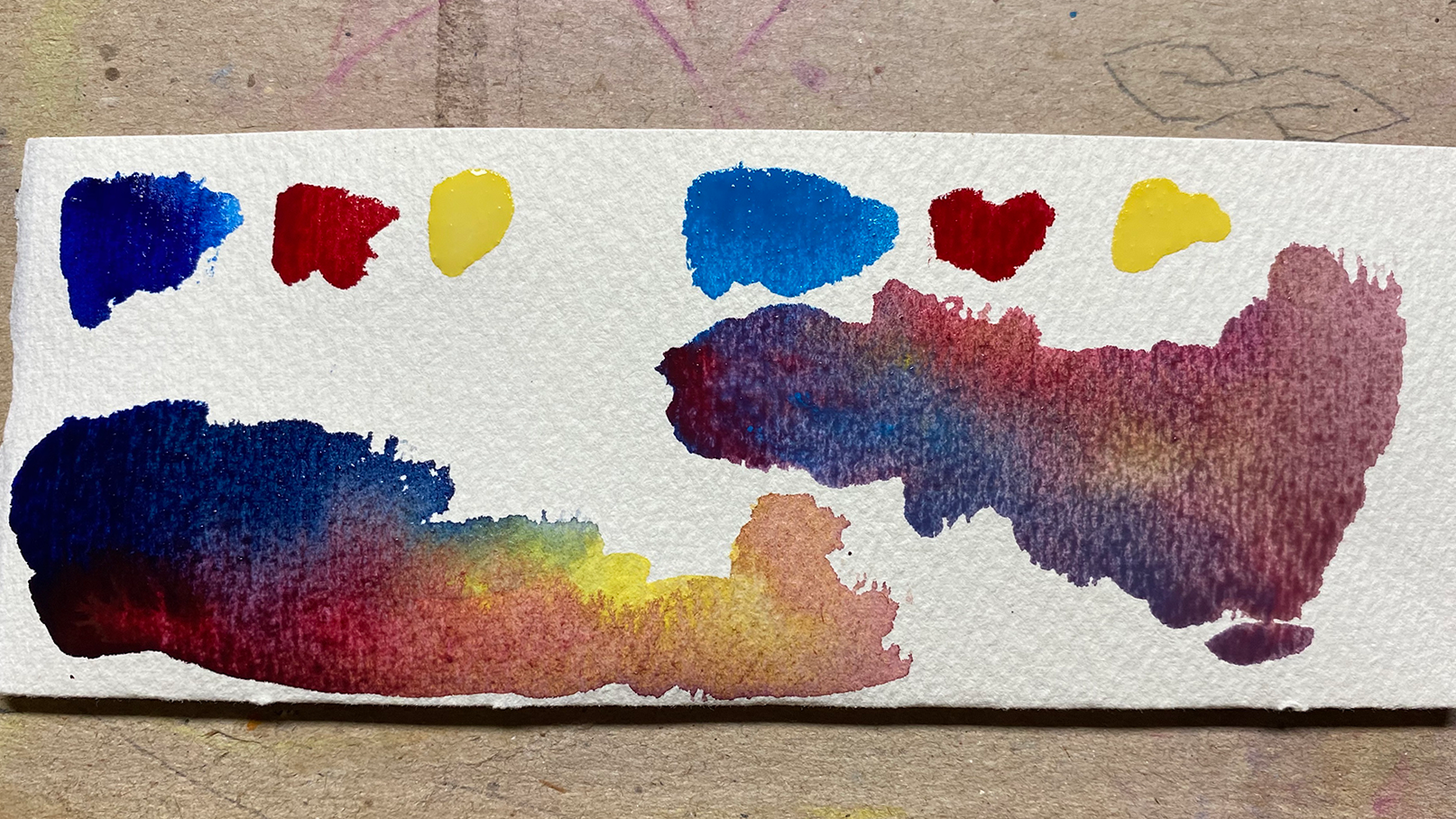Mixing Blacks and Browns with Three Primary Pigments
Apr 15, 2020
Earlier this week a student in the Color Wheel Mandala Class - Part II on Skillshare asked a very good question. I realized the answer might be of interest to more than just Carol.
In my latest (4th) mandala that I just posted, I was using Nickel Quin Yellow, Manganese Blue hue, and Alizarin Crimson. As I was finishing up I wanted to make a black or gray so I could use that for part of the design. No matter what colors - like all the primary ones - I could not get a black or gray. I kept getting brown. I must be under the mistaken impression that one can mix blacks from opposite colors and or mixing three colors together. I gave up after 5 or 6 tries and a bunch of paint! Can you enlighten me on this? Is it not true for certain primary colors?
Carol S
My response was "Yes ... and No". I promised a more complete, illustrated explanation using the pigments she mentioned as well as switching out her manganese blue for Joe's blue (phthalo). There are two and a half reasons that Carol ran into difficulty creating a black from her three pigments.
Reason One:

Left - Joe's Blue Right: Manganese Blue
In both of the swatches illustrated above, I show each pigment as both fully saturated as well as diluted. In the little horizontal strip at the bottom, you can see that the fully saturated Joe's Blue is far darker in value (grayscale) than manganese blue. Manganese cannot be any darker and still be pure manganese out of the tube.
The only way to create a darker value of any pigment is to mix it with another pigment that is darker. Using more of the original pigment (in watercolor) only makes it more opaque, not darker.

Three pigments: manganese, alizarin crimson, nickel yellow
The image above illustrates a result of mixing only the blue and red together ... then adding a wee bit of the yellow in the middle. I wanted to show how the yellow turned the mix away from a gray toward a brown.
Just as a pigment can be made a darker value by adding a pigment that is naturally a darker pigment (Joe's Blue is darker in value than Manganese), a pigment is made immediately lighter in value by adding a pigment that is naturally a lighter value pigment. Yellow pigment is lighter in value than any red and any blue. No matter what you add yellow to, it will lighten the mix, definitely moving it away from black.
The darkest dark you can achieve with these three pigments is to use only the alizarin crimson by itself in full strength. The alizarin, by nature, is a darker value than the manganese. By mixing the manganese with the alizarin, you are lightening the value of the alizarin, moving away from black, the darkest dark possible. You can achieve beautiful, rich violets, red-violets and blue-violets, but nothing any darker than the alizarin. By adding the touch of yellow, you achieve gorgeous neutrals that range from grays to browns ... but you don't achieve anything close to a black.
The half a reason is the fact that Carol was using manganese hue, not manganese. When the word hue is used in the name it indicates more binder and less pigment used in the manufacturing of the paint. To achieve the same intensity of a pigment you need to use more manganese hue than you do manganese. It's not always a more economical choice to purchase hues. Depending on your painting technique, you may need far more tubes of the hue than you would need of the more pigmented version. Many student grade pigments are hues.
Reason Two:
Remember what I wrote about adding yellow to the mix.
On the color wheel, manganese is closer to yellow than Joe's blue. This indicates that manganese is reflecting light waves that our eyes read as green. Green, the result of both yellow and blue wave lengths will neutralize the mix just as the yellow did. The mix will tend more toward brown than gray and will never be as dark as a black.

Left: Joe's blue, alizarin, nickel yellow
Right: manganese, alizarin, nickel yellow
When Joe's blue is used rather than manganese, you can see that a rich dark, can be achieved, close to black and with far more life and depth than a pure black would have.
Additional info - When mixing three primary colors, if you want your neutrals to head in the direction of cool gray rather than brown, stay away from warm reds and/or warm blues. If you are using a cool red and a cool blue, it's possible to add a bit of a yellow and still achieve a lovely cool gray. Using a warm red and/or a warm blue with a smidgeon of yellow may still give you a warm gray as well as rich browns.
See the list of common pigments at the end of this post that refers to the pigments as either warm or cool.
Historical Note on Pigments Manganese and Cerulean:
In my mind, I think of manganese blue as a slightly darker version of cerulean. It is so close that I thought I might do a bit of research to see if they are, in any way, related. I looked to David Coles' book, Chromatopia, for information.
At one time, the name cerulean was applied to mixtures of copper and cobalt oxides such as natural azurite and synthetic smalt. A prototype of cerulean blue was developed in the late 18th century by a chemist named Albrecht Höpfner ... and forgotten, only to be rediscovered in the 1860's. It became popular among artists in the mid-19th century because of its stability and permanence. In a second version, tin was replaced by chromium resulting in a slightly green color that is known as cobalt turquoise (one of my favorite pigments!)
Manganese blue is a clear azure blue, discovered in 1907, but was not commercially produced until the mid-1930's. Because of it being a relatively weak tint as well as concerns over its environmental toxicity, its production was discontinued in the 1990's. (Hmmmmm. It's still available today.)

Variations of the Flower Petal Color Wheel Mandala presented in Part II of the Color Wheel Mandala series on Skillshare
*****
Interested in free online demo videos? Visit my youtube channel.
Interested in taking one of my online art courses? I offer bite-sized classes on Skillshare and comprehensive classes on ExploreWithChrisCarter.com.
If you aren't already a premium member on Skillshare, please check it out. You receive a two month trial period totally free when you click on my link: Skillshare.com/chriscarterart
I'm creating most of the classes on Skillshare as bite-size classes within a series. Each series, as I complete it will be bundled together with additional lessons added to it to create a more comprehensive course here on ExploreWithChrisCarter.com for artists who truly want to learn new skills and master their current skills.
Thanks for reading my blog!
Common Pigments - Which are warm and which are cool?
Cool Yellows: Cadmium Lemon, Hansa Yellows, Bismuth Yellow, Lemon Yellows, Nickel Titanate, Aureolin
Warm Yellows: Cadmium Yellows, Hansa Yellow Deep, Gamboge, Nickel Dioxine, Yellow Ochre
Cool Blues: Cobalt Teal, Cobalt Turquoise, Cerulean Blue, Phthalo Blue, Manganese Blue, Joe’s Blue
Warm Blues: Ultramarine Blue, Indanthrone Blue
Cool Reds: Magenta, Alizarin Crimson, Quinacridone Carmine, Quinacridone Rose, Quinacridone Crimson
Warm Reds: Cadmium Reds, Vermillion, Pyrrole Red, Cadmium Scarlet, Pyrrole Scarlet
Subscribe
Join my mailing list to receive notification of new blog posts and update on the online courses.
Don't worry, your information will not be shared.
We hate SPAM. We will never sell your information, for any reason.
